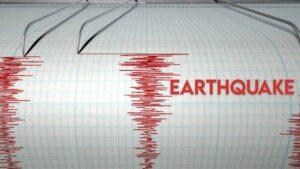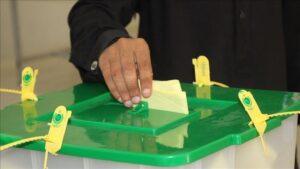People surround the Nagin Chowrangi water hydrant during a protest against water shortage. Photo: PPI
KARACHI:
Residents of northern Karachi stormed the Nagan Chowrangi pumping station in the early hours of Sunday to protest severe water shortages that have persisted for weeks.
A large number of women took part in the demonstration, during which the protesters exchanged harsh words with the staff of Karachi Water and Sewerage Corporation (KWSC). Some angry residents allegedly attempted to manhandle staff as tempers flared.
Protesters said that despite repeated assurances, the KWSC had failed to restore water supply to their homes for more than a month. Many women complained that the purchase of water tankers had become unaffordable and unsustainable for households already under financial pressure.
Shouting “Pani do, pani do” (give us water), the crowd demanded the immediate restoration of supplies. Police from Taimuria police station reached the spot after receiving reports of the unrest and held negotiations with the protesters. The protest was called off after successful talks and the crowd dispersed peacefully.
Drawing fault lines
Water and electricity companies blame each other for disruptions to water supplies in the city.
Following the K-Electric spokesperson’s statement that power supply at water pumping stations is normal, the KWSC spokesperson attributed the power outages to pipe bursts and supply outages. However, the KE spokesperson blamed leaky pipes that drip water onto power cables, causing short circuits and power outages at pumping stations.
The Karachi Water and Sewerage Corporation (KWSC) reported on Sunday that prolonged power outages at major pumping stations caused a shortfall of 884 million gallons of water across the city during November 2025.
According to a KWSC spokesperson, repeated power outages caused by K-Electric severely disrupted pumping operations throughout the month. The Dhabeji pumping station was the hardest hit, suffering 132 hours and 20 minutes of power outages, resulting in a shortfall of 424 million gallons.
Similarly, 146 hours of outages at the Dumlottee station resulted in a loss of 111 million gallons, while the northeast Karachi station recorded a deficit of 335 million gallons. The Hub and Pipri stations each reported a 6 million gallon deficiency, and the Gharo station faced a 2 million gallon shortfall.
Officials said continued power outages paralyzed operations at central pumping stations for several hours, affecting water supply across Karachi. They urged K-Electric to ensure stable and uninterrupted power supply to key pumping stations, warning that repeated cable failures were damaging critical pumping machinery.
They stressed the need for alternative feeders, backup cables and urgent technical upgrades to safeguard the city’s water supply system from future disruptions.
The spokesperson added that KWSC maintains close coordination with K-Electric to ensure stable supply and that water distribution throughout the city returned to normal once power was restored. He said all possible measures were being taken to further improve the system and ensure uninterrupted supply of water to residents.
KE asks KWSC to repair leaking pipes
The KE spokesperson said the electricity supply remains stable at all water pumping stations, but leaks in the pipelines are hampering repair work. He said power line repairs cannot be carried out in standing water due to risks to staff safety. Water leaking from KWSC’s pipes submerges underground power cables, damaging the infrastructure that supplies electricity to these stations. The spokesperson noted that the persistent leak had been officially reported to authorities on November 10, following a previous notification in June.
Fixing electrical cables in standing water is extremely challenging and time-consuming. He further explained that standing water creates additional complications, such as bush growth, that hamper testing and debugging. Meanwhile, as water and power companies blame each other, residents of the metropolis continue to suffer disruptions to their water supply.




